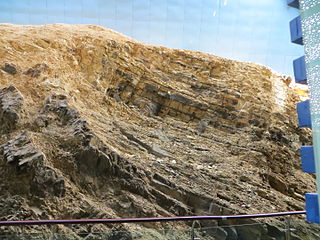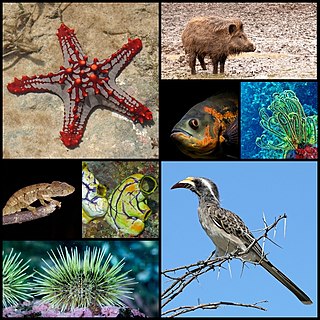
A chordate is a deuterostomic animal belonging to the phylum Chordata. All chordates possess, at some point during their larval or adult stages, five distinctive physical characteristics (synapomorphies) that distinguish them from other taxa. These five synapomorphies are a notochord, a hollow dorsal nerve cord, an endostyle or thyroid, pharyngeal slits, and a post-anal tail. The name "chordate" comes from the first of these synapomorphies, the notochord, which plays a significant role in chordate body plan structuring and movements. Chordates are also bilaterally symmetric, have a coelom, possess a closed circulatory system, and exhibit metameric segmentation.

The Maotianshan Shales (帽天山页岩) are a series of Early Cambrian sedimentary deposits in the Chiungchussu Formation, famous for their Konservat Lagerstätten, deposits known for the exceptional preservation of fossilized organisms or traces. The Maotianshan Shales form one of some forty Cambrian fossil locations worldwide exhibiting exquisite preservation of rarely preserved, non-mineralized soft tissue, comparable to the fossils of the Burgess Shale of British Columbia, Canada. They take their name from Maotianshan Hill in Chengjiang County, Yunnan Province, China.

Yunnanozoon lividum is an extinct species of bilaterian animal from the Lower Cambrian Chengjiang biota of Yunnan province, China. Its affinities have been long the subject of controversy.

Vetulicola is an extinct genus of marine animal discovered from the Cambrian of China. It is the eponymous member of the enigmatic phylum Vetulicolia, which is of uncertain affinities but may belong to the deuterostomes. The name was derived from Vetulicola cuneata, the first species described by Hou Xian-guang in 1987 from the Lower Cambrian Chiungchussu Formation in Chengjiang, China.

Pomatrum is an extinct vetulicolian, the senior synonym of Xidazoon; the latter taxon was described by Shu, et al. (1999) based on fossils found in the Qiongzhusi (Chiungchussu) Formation, Yu'anshan Member, Lower Cambrian, Haikou, (Kunming), about 50 km west of Chengjiang, China. It has been likened to the chordate Pipiscius.

Banffia is a genus of animals described from Middle Cambrian fossils. The genus commemorates Banff, Alberta, near where the first fossil specimens were discovered. Its placement in higher taxa is controversial. It is considered to be a member of the enigmatic phylum Vetulicolia.

Vetulicolidae is an extinct family of Early Cambrian deuterostomes comprising two genera: Vetulicola and Ooedigera.

Deuterostomes are bilaterian animals of the superphylum Deuterostomia, typically characterized by their anus forming before the mouth during embryonic development. Deuterostomia is further divided into 4 phyla: Chordata, Echinodermata, Hemichordata, and the extinct Vetulicolia known from Cambrian fossils. The extinct clade Cambroernida is also thought to be a member of Deuterostomia.

Vetulicola cuneata is a species of extinct animal from the Early Cambrian Chengjiang biota of China. It was described by Hou Xian-guang in 1987 from the Lower Cambrian Chiungchussu Formation, and became the first animal under an eponymous phylum Vetulicolia.

Herpetogaster is an extinct cambroernid genus of animal from the Early Cambrian Chengjiang biota of China, Blang Formation of China, Pioche Formation of Nevada and Middle Cambrian Burgess Shale of Canada containing the species Herpetogaster collinsi and Herpetogaster haiyanensis.

Ooedigera peeli is an extinct vetulicolian from the Early Cambrian of North Greenland. The front body was flattened horizontally, oval-shaped, likely bearing a reticulated or anastomosing pattern, and had 5 evenly-spaced gill pouches along the midline. The tail was also bulbous and flattened horizontally, but was divided into 7 plates connected by flexible membranes, allowing movement. Ooedigera likely swam by moving side-to-side like a fish. It may have lived in an oxygen minimum zone alongside several predators in an ecosystem based on chemosynthetic microbial mats, and was possibly a deposit or filter feeder living near the seafloor.

Skeemella clavula is an elongate animal from what is now the Middle Cambrian Wheeler Shale and Marjum lagerstätte of Utah. It has been classified with the vetulicolians.

Vetulicola rectangulata is a species of extinct animal from the Early Cambrian of the Chengjiang biota of China. Regarded as a deuterostome, it has characteristic rectangular anterior body on which the posterior tail region is attached. It was described by Luo Huilin and Hu Shi-xue in 1999.

Nesonektris aldridgei is an extinct deuterostome chordate from the Late Botomian-aged Emu Bay Shale Lagerstätte in Kangaroo Island, Australia. So far, it is the fourth described vetulicolian that is not restricted to the Maotianshan Shales.

Olfactores is a clade within the Chordata that comprises the Tunicata (Urochordata) and the Vertebrata. Olfactores represent the overwhelming majority of the phylum Chordata, as the Cephalochordata are the only chordates not included in the clade. This clade is defined by a more advanced olfactory system which, in the immediate vertebrate generation, caused the appearance of nostrils.

Saccorhytus is an extinct genus of animal possibly belonging to the superphylum Ecdysozoa, and it is represented by a single species, Saccorhytus coronarius. The organism lived approximately 540 million years ago in the beginning of the Cambrian period. Initially proposed as a deuterostome, which would make it the oldest known species of this superphylum, it has since been determined to belong to a protostome group called the ecdysozoans.
Shankouclava is an extinct genus of tunicates. It represents the oldest candidate member of this group, dating to 518 million years ago. It has been found in the Lower Cambrian Maotianshan Shale at Shankou village, Anning, near Kunming. Each of the eight specimens found and used for description were isolated, suggesting that the genus was solitary and not colonial.

Beidazoon venustum is a deuterostome from the deuterostome group Vetulicolia. It originates from the lower Cambrian Chengjiang biota of Yunnan Province, China. Beidazoon was a marine organism discovered by Degan Shu in 2005.

Vetulocystidae is the only family of the taxon Vetulocystida, which is a group of extinct deuterostomes of uncertain phylogenetic position. Vetulocystidae is made up of the genera Vetulocystis, Dianchicystis and Thylacocercus.
The Cambrian chordates are an extinct group of animals belonging to the phylum Chordata that lived during the Cambrian, between 538 and 485 million years ago. The first Cambrian chordate known is Pikaia gracilens, a lancelet-like animal from the Burgess Shale in British Columbia, Canada. The discoverer, Charles Doolittle Walcott, described it as a kind of worm (annelid) in 1911, but it was later identified as a chordate. Subsequent discoveries of other Cambrian fossils from the Burgess Shale in 1991, and from the Chengjiang biota of China in 1991, which were later found to be of chordates, several Cambrian chordates are known, with some fossils considered as putative chordates.





















